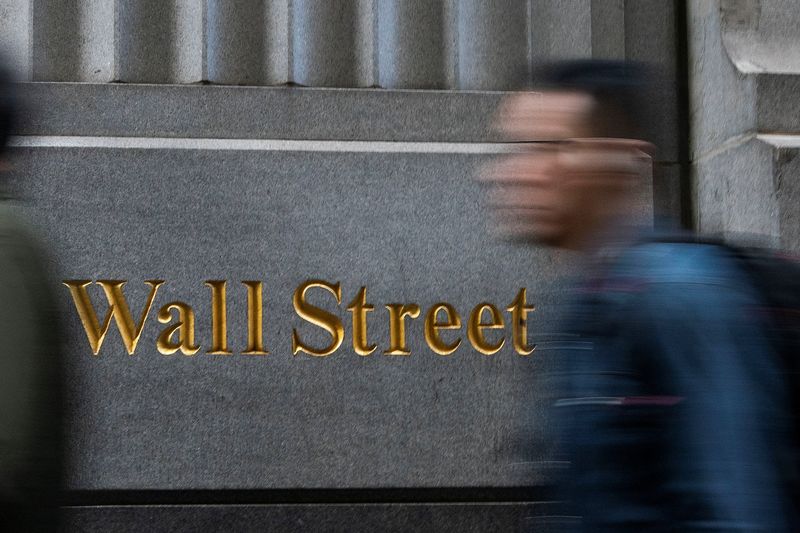By Jamie McGeever
ORLANDO, Florida (Reuters) -History suggests Wall Street's recent 5% mini-correction won't be its last this year, but stocks face potentially higher earnings and interest rate hurdles in the second half of the year if investors' bullish expectations are to be met.
The U.S. exceptionalism narrative is alive and well - a strong economy, the artificial intelligence (AI) revolution and fat corporate profits - which optimists will say is reason enough to buy any dip in the event of any more corrections.
Investors are overwhelmingly positioned for that narrative to continue delivering this year, but Wall Street may have peaked too early.
The S&P 500 index retreated 5.5% from its all-time high of 5,264.85 points on March 28 to last Friday, a mini-correction spanning 22 days. In terms of depth and length, it was a mild decline, the index was still up on a year-to-date basis, and is rebounding.
But it must be remembered that the March 28 peak was the culmination of an explosive 30% rally over the preceding five months, propelled by an even more frenzied surge in a handful of mega tech stocks.
So if the recent consolidation was down to profit-taking, there's plenty more profit to take. According to analysts at AJ Bell, the combined market cap of the "Magnificent Seven" stocks just fell $1.1 trillion in six days to $12.9 trillion, but that is still up almost $3 trillion from Oct. 25 when the rally started.
And history shows there are usually multiple pullbacks of 5% or more in a calendar year, and the average intra-year peak-to-trough drawdown runs into double digits.
Ryan Detrick, chief market strategist at Carson Group, calculates that the S&P 500 on average registered 3.4 pullbacks of 5% per year in the 1928-2023 period, and just over one correction of 10% per year.
If the recent 5.5% pullback turns out to be the maximum this year, it will be the fifth-smallest in almost a century, Detrick says.
Analysts at Raymond James note that since 1981 the index's maximum intra-year, peak-to-trough drawdown has averaged around 13%-14%. Even if that unfolds this year, they are confident the market will bounce back.
"Stronger economic growth leads to upside for corporate earnings - the indicator with the strongest predictive power for future equity returns. As a result, we reiterate our year-end S&P 500 target of 5,200," they wrote on Friday.
Yet 5,200 is only around 5% from current levels, and is where the index was earlier this month. The bar for the 5,400 year-end target UBS, HSBC and Bank of America are aiming for, never mind the 5,500 target of Oppenheimer and Societe Generale (OTC:SCGLY), is much higher.
EQUITY RISK PREMIUM EVAPORATES
SocGen's equity strategy team points to record 12-month forward earnings estimates of almost $250 as a key plank of their year-end target of 5,500. That implies around 10% upside from Monday's closing level.
That might be a challenge if the Federal Reserve doesn't cut interest rates at all this year, as SocGen economists are now forecasting.
Interest rate markets have been cutting back the amount of implied policy easing this year to around 40 basis points from 160 basis points in January, but they haven't got to "no change" yet. A Fed on hold all year is not factored into the price of any asset class.
"While no Fed rate cuts would wipe out the 'blue-sky' scenario for the S&P 500, we should not expect a wholesale risk-off across assets," SocGen strategists Manish Kabra and Alain Bokobza wrote on Friday.
If a JP Morgan survey of 370 investors carried out between March 26 and April 17 is any guide, it's a widespread melt-up in risk assets that market participants are positioned for, not a correction.
Some 83% of respondents expect the S&P 500 to end the year at 5,000 points or higher, and two-thirds are forecasting 5,250 or higher.
Almost half of them say the biggest threat to risk assets this year is either resurgent inflation, or higher interest rates and the Fed on hold, while 10% are most concerned about elevated valuations.
The first-quarter U.S. earnings reporting season is underway, and a high percentage of firms will beat the aggregate year-on-year blended earnings growth forecast of 2.9%, which has been steadily lowered in recent weeks.
But earnings growth forecasts for the second, third and fourth quarters of 11%, 9% and 15%, respectively, will be much harder to beat. That's when valuations of more than 20 times forward earnings, the highest in the developed world, begin to look stretched.
The equity market outlook this year is still positive but not straightforward. Interest rates, positioning and valuations are challenges to overcome, and some investors may prefer to hold back for now.
The equity risk premium, the extra yield investors want from putting their money into riskier stocks over "risk-free" U.S. Treasuries, has virtually disappeared. Right now, bonds may be more tempting than stocks.
(The opinions expressed here are those of the author, a columnist for Reuters.)
